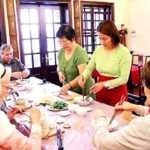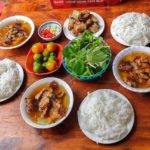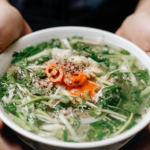Not only does Hanoi’s cuisine attract tourists from all over the world, but it has also captivated renowned politicians and culinary experts, including former French President François Hollande, former U.S. President Barack Obama, South Korean President Yoon Suk-yeol, Dutch Prime Minister Mark Rutte, US Secretary of State Antony John Blinken, and the late celebrity chef Anthony Bourdain.
| Australian Prime Minister Anthony Albanese indulges in Hanoi draft beer during his visit to Vietnam in June 2023. Photo: VNA |
Many of Hanoi’s dishes have garnered recognition from foreign travel websites, earning them a place in their guides. This has given the city a fresh impetus to promote its gastronomic culture and enhance its competitiveness as a cultural product.
A significant asset for the cultural sector
Hanoi’s cuisine is considered a cultural heritage with both material and spiritual components, encompassing ingredients, recipes, flavors, scents, and dining etiquettes. These characteristics hold not only socio-economic significance but also exemplify cultural abundance, bolstering the city’s reputation and drawing both domestic and international tourists.
Visitors often crave local delicacies, particularly traditional dishes deeply rooted in Vietnamese cultural identity such as beef noodle soup, Hanoi spring rolls, snail vermicelli soup, West Lake shrimp cakes, fish cakes, rice vermicelli with grilled pork and herbs, green rice flakes, and egg coffee. At night, the Old Quarter comes alive with specialized culinary streets like Ta Hien, Ma May, Cau Go, Dong Xuan, Luong Ngoc Quyen, Tong Duy Tan, and Hang Cot, bustling with tourists. The city has expanded the culinary scene in other areas to augment its tourism appeal, including the Dao Ngoc – Ngu Xa nighttime culinary and pedestrian zone, West Lake Temple food street, and a plethora of traditional cuisine restaurants.
| A Hanoi specialty: Bun rieu, a fresh noodle soup with rice field crab. Photo: Thanh Hang |
In 2023, the Michelin Guide, the world’s most prestigious culinary guide, recommended 48 restaurants in Hanoi and 55 in Ho Chi Minh City. Of these, three received one-star ratings. Furthermore, readers of the leading travel site TripAdvisor voted Hanoi the world’s best food destination in 2024, following its third-place ranking in 2023.
According to Pham Quynh Phuong, Head of the Department of Cultural and Creative Industries at Vietnam National University, Hanoi, cuisine plays an indispensable role within the cultural industries ecosystem as a significant cultural element, both materially and spiritually, contributing to the interaction between culture and the economy.
Many researchers argue that cuisine has become a competitive advantage and a key branding element for countries and tourist destinations. For instance, Italy is renowned not only for its Renaissance art but also as the birthplace of pizza. Similarly, France’s rich culture and history are coupled with its reputation as the cradle of classic cuisine and cheese-making techniques. Meanwhile, China boasts four major culinary schools: Guangdong, Shandong, Sichuan, and Jiangsu.
| Famous international TikTokers savor Pho cuon, rolled Pho with beef and fresh herbs, at a restaurant in Ngu Xa Night Food Street. Photo: Pho cuon Chinh Thang |
Hanoi possesses tremendous potential and advantages for transforming its cuisine into a cultural product. However, the utilization of Hanoi’s cuisine for cultural industry development is still at a nascent stage and lacks a specific, systematic plan. As part of the Hanoi Party Committee’s resolution on developing cultural industries in the capital from 2021 to 2025, with a vision to 2030 and 2045, cuisine is acknowledged as one of the city’s fields with great potential and advantage in cultural industry development.
Turning cuisine into a cultural sector product
“Currently, there are numerous culinary competitions, but they often end up as mere game shows and fail to yield substantial cultural value for development. It is crucial for Hanoi to capitalize on the quintessential value of its cuisine and nurture it into a valuable cultural product,” said Do Dinh Hong, Director of Hanoi’s Department of Culture and Sports.
| A serving of bun cha, grilled pork with noodles, another Hanoi specialty. Photo: Thanh Hang |
To develop a suitable direction for the exploitation and development of gastronomic culture as a cultural product, substantial commitment is necessary from administrative bodies, local authorities, as well as organizations and individuals dedicated to preserving culture.
In recent years, Hanoi has organized various activities to promote the city’s cuisine to domestic and foreign tourists. These include the annual Quintessential Vietnamese Cuisine event, which brings together professional associations, artisans, businesses, and restaurants to showcase the delicacies of Hanoi and the country as a whole.
Hanoi’s traditional cultural and culinary values are also celebrated, preserved, and promoted through the annual Hanoi Culinary Culture Festival. However, these efforts seem insufficient to elevate the standard of Hanoi’s gastronomy.
Culinary services and products will be diversified to meet the needs of both citizens and tourists, with a focus on unique types such as night food streets and culinary craft villages, aligned with Hanoi City’s tourism development direction until 2030. The Hanoi Department of Tourism plans to create a food tour map, allowing visitors to explore and experience the local cuisine at their own pace.
| International visitors enjoying the ambiance of Ngu Xa Night Food Street. Photo: Duy Khanh |
Hanoi University of Culture suggests that the city formulate strategies and plans for promoting food culture within the context of cultural industry development. On one hand, the city should identify target markets and design appropriate and effective promotion programs. On the other hand, investments in food tours and culinary products should be prioritized.
Moreover, to transform cuisine into a lucrative product of the cultural sector, Hanoi needs to organize domestic and international exchanges and cooperation activities centered on its culinary culture. Policies providing support for the development of the startup ecosystem, particularly in the culinary culture field, should also be implemented.
Hanoians have long been regarded as connoisseurs of both food and fashion, and Hanoi’s gastronomy is truly unique. Transforming this resource into a valuable cultural product that benefits the capital requires meticulous evaluation followed by systematic investment.
Young green rice – flavor of autumn
For over a century, people of Me Tri village in Tu Liem, Hanoi, have been making ‘com’. Visiting Me Tri in autumn, one can enjoy the scent of com (young milky rice) being dried all over the village.




.jpg)








